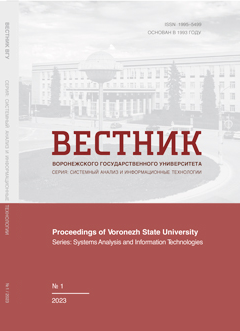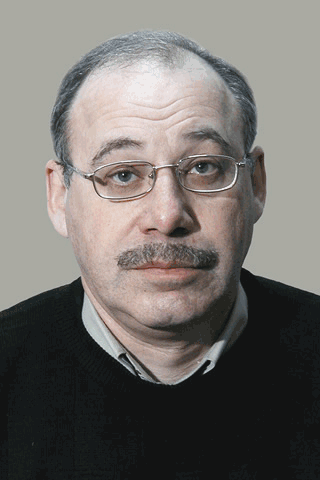Дискретная однородная цепь Маркова для нечетких состояний
Аннотация
В результате проведенных исследований разработана методика построения однородной цепи Маркова для системы с нечеткими состояниями, основанная на обработке данных временных рядов выходов системы. В отличие от известных нечетких цепей Маркова переходная матрица не рассматривается как нечеткое отношение, а остается обычной стохастической матрицей. Такой подход позволяет получать стационарные состояния системы, которые характеризуют ее статус на некотором заданном временном промежутке. Эта информация может использоваться в системе поддержки принятия решений по целенаправленному изменению статуса. Особенностью полученной цепи Маркова для нечетких состояний системы является возможность учета динамики изменения состояний системы при расчете средних значений статуса, в отличие от широко применяемой ориентации на усреднения, основанные на вычислении средних арифметических. Приводятся численные эксперименты с построенной цепью Маркова для нечетких состояний, которые подтверждают ее адекватность и возможности учета динамики. Эксперименты приведены на примере оценки статуса обучающегося в системе образования.
Скачивания
Литература
2. Volkova V. N. and Emelyanov A. A. (2006) Systems theory and system analysis in the management of organizations: Guide. Moscow: Finance and Statistics.
3. Peregudov F. I. and Tarasenko F. P. (1989) Introduction to system analysis. Moscow: Higher School.
4. Wenzel E. S. (1988) Operations research. Tasks, principles, methodology. Moscow: Gl. ed. phys.-mat. lit.
5. Avrachenkov K. E. and Sanchez E. (2002) Fuzzy Markov Chains and Decision-Making. Fuzzy Optimization and Decision Making. 1(2). P. 143–159. DOI
6. Guangming L. and Baoxin X. (2014) Fuzzy Markov chains based on the fuzzy transition probability. 26th Chinese Control and Decision Conference (CCDC) 9781479937080, IEEE. P. 4351–4356. DOI
7. Poleshchuk O. M. (2014) Fuzzy probability spaces and probabilities of fuzzy events. Forestry Bulletin. 4. P. 162–169
8. Bursikov A. V., Aleksandrov M. V. and Rupasova T. I. (2009) Evaluation of patient general status in out-patient practice. Bulletin of the Ivanovo Medical Academy. 14(4). P. 51–54.
9. Zaleshchansky B. D., Sviridov A. P., Shabolina O. A. and Shabolina E. A. (2013) Probabilistic and statistical strategies for ensuring the training of personnel of sociotechnical systems. Information technologies. 8. P. 67–70.
10. Sheremet A. D. (2020) Analysis and diagnostics of financial and economic activity of the enterprise: textbook. Moscow: INFRA-M.
11. Efimova O. V. (2010) Financial analysis: modern tools for making economic decisions. Omega-L.
12. Vygodchikova I. Yu., Trofimenko A. V. and Forkunov N. P. (2020) Methodology of rating evaluation of companies from the point of view of their investment attractiveness. Mathematical and computer modeling in economics, insurance and risk management. 5. P.50–54.
13. Khvostov A. A. and Sinyukov V. V. (2017) Modeling of the cadet training process based on Markov chains. Military space forces. Theory and practice. 1. P. 311–316.
14. Korenevsky N. A., Filatova O. I., Burmaka A. A. and Serebrovsky V. V. (2012) Method of classifying the functional state of a person and assessing the level of its components based on hybrid fuzzy models. Biotechnosphere. 1(19). P. 41–44.
15. Yarushkina N. G. Afanasyeva T. V. and Perfilieva I. G. (2010) Intellectual analysis of time series. Ulyanovsk: UlSTU.
16. Batyrshin I. and Sheremetov L. (2007) Perception Based Time Series Data Mining for Decision Making. IFSA’07Theoretical Advances and Applications of Fuzzy Logic. P. 209–219. DOI
17. Giove S. (2009) Fuzzy logic and Clustering methods for time series analisys. International Fuzzy Systems Association World Congress and 2009 European Society for Fuzzy Logic and Technology Conference (IFSA-EUSFLAT 2009).
18. Herbst G. and Bocklish S. F. (2009) Online Recognition of fuzzy time series patterns. 2009 International Fuzzy Systems Association World Congress and 2009 European Society for Fuzzy Logic and Technology Conference (IFSA-EUSFLAT 2009).
19. Yarushkina N. G. (2009) Modern intellectual analysis of fuzzy time series. Proceedings of the V International Scientific and Practical Conference «Integrated models and soft computing» (Kolomna, May 20–30, 2009).
20. Ledeneva T. M., Sergienko M. A. and Tikhomirova E. A. (2020) Formation of a knowledge base based on the allocation of typical states of a complex system. Bulletin of Voronezh State University. Series: System analysis and Information Technologies. 1. P. 140–151. DOI
21. Ledeneva T. M. (2006) Processing of fuzzy information. Voronezh: Voronezh State University.
22. Kosko B. (1992) Neural Networks and Fuzzy Systems: a Dynamical Systems Approach to Machine Intelligence. Prentice-Hill.
23. Perfilieva I. (2006) Fuzzy transforms: Theory and applications. Fuzzy Sets and Systems. 157. P. 63–82.
24. Batyrshin I. Z. and Sheremetov L. B. (2007) Models and methods of perceptual time series data mining for decision support systems. Fuzzy systems and soft computing. 1(2). P.29–52.
25. Song Q. and Chissom (1993) Forecasting enrollments with fuzzy time series – Part I. Fuzzy Sets and Systems. 54. Р. 1–9.
26. Song, Q. and Chissom B. (1994) Forecasting enrollments with fuzzy time series – Part II. Fuzzy Sets and Systems. 64. Р. 1–8.
27. Zadeh L. A. (1968) Probability measures and fuzzy events. Math. Anal. Appl. 23, 421 427.
28. Yager R. (1979) A note on probabilities of fuzzy events. Information Sci. 128, 113 129
29. Gudder S. (2000) What Is Fuzzy Probability Theory? Foundations of Physics. Vol. 30, No. 10.
30. Meyers R. A. (ed.) (2001) Encyclopвia of Physical Science and Technology. 3rd Edition.V. 18. Academic Press.
31. Guixiang W., Yifeng X. and Sen Q. (2019) Fuzzy Event Space and Probability Distribution of Probability Fuzzy Space. Mathematics. 7. P. 542. DOI
- Авторы сохраняют за собой авторские права и предоставляют журналу право первой публикации работы, которая по истечении 6 месяцев после публикации автоматически лицензируется на условиях Creative Commons Attribution License , которая позволяет другим распространять данную работу с обязательным сохранением ссылок на авторов оригинальной работы и оригинальную публикацию в этом журнале.
- Авторы имеют право размещать их работу в сети Интернет (например в институтском хранилище или персональном сайте) до и во время процесса рассмотрения ее данным журналом, так как это может привести к продуктивному обсуждению и большему количеству ссылок на данную работу (См. The Effect of Open Access).



















